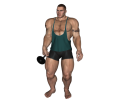 Wrist Abduction - Single Ended Dumbbell
Wrist Abduction - Single Ended Dumbbell
Benefits: This exercise focuses on the wrist abductors, a muscle group that hardly is ever exercised in the gym.
Purpose: This exercise strengthens the muscles that abduct the wrist.
Beginner Forearms Strength Single Ended Dumbbell Pull Gym
General Info: A complete forearm program must achieve balanced development for all major forearm muscles. The forearm is involved in six different forearm movements. They include wrist flexion, wrist extension, wrist abduction, wrist adduction, forearm pronation, and forearm supination. There are additional muscles found in the forearm that are involved in movements like elbow flexion (brachioradialis), finger flexion, and finger extension.
 Wrist Abduction - Water Bottle
Wrist Abduction - Water Bottle
Benefits: This exercise focuses on the wrist abductors, a muscle group that hardly is ever exercised in the gym.
Purpose: This exercise strengthens the muscles that abduct the wrist.
Beginner Forearms Strength Water Bottle Pull Home
General Info: A complete forearm program must achieve balanced development for all major forearm muscles. The forearm is involved in six different forearm movements. They include wrist flexion, wrist extension, wrist abduction, wrist adduction, forearm pronation, and forearm supination. There are additional muscles found in the forearm that are involved in movements like elbow flexion (brachioradialis), finger flexion, and finger extension.
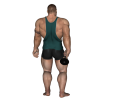 Wrist Adduction - Single Ended Dumbbell
Wrist Adduction - Single Ended Dumbbell
Benefits: This exercise focuses on the wrist adductors, a muscle group that hardly is ever exercised in the gym.
Purpose: This exercise strengthens the muscles that adduct the wrist.
Beginner Forearms Strength Single Ended Dumbbell Pull Gym
General Info: A complete forearm program must achieve balanced development for all major forearm muscles. The forearm is involved in six different forearm movements. They include wrist flexion, wrist extension, wrist abduction, wrist adduction, forearm pronation, and forearm supination. There are additional muscles found in the forearm that are involved in movements like elbow flexion (brachioradialis), finger flexion, and finger extension.
 Wrist Adduction - Water Bottle
Wrist Adduction - Water Bottle
Benefits: This exercise focuses on the wrist adductors, a muscle group that hardly is ever exercised in the gym.
Purpose: This exercise strengthens the muscles that adduct the wrist.
Beginner Forearms Strength Water Bottle Pull Home
General Info: A complete forearm program must achieve balanced development for all major forearm muscles. The forearm is involved in six different forearm movements. They include wrist flexion, wrist extension, wrist abduction, wrist adduction, forearm pronation, and forearm supination. There are additional muscles found in the forearm that are involved in movements like elbow flexion (brachioradialis), finger flexion, and finger extension.
 Wrist Circles - Fundamental
Wrist Circles - Fundamental
Benefits: This exercise focuses on wrist flexibility.
Purpose: This exercise provides more flexibility in the wrist.
Intermediate Forearms Strength Body Only Gym
General Info: A complete forearm program must achieve balanced development for all major forearm muscles. The forearm is involved in six different forearm movements. They include wrist flexion, wrist extension, wrist abduction, wrist adduction, forearm pronation, and forearm supination. There are additional muscles found in the forearm that are involved in movements like elbow flexion (brachioradialis), finger flexion, and finger extension.
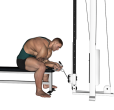 Wrist Curl - Cable
Wrist Curl - Cable
Benefits: This exercise focuses on the wrist flexors with the forearms supinated.
Purpose: This exercise strengthens the muscles that flex the wrist.
Beginner Forearms Strength Cable Machine Flat Bench Pull Gym
General Info: A complete forearm program must achieve balanced development for all major forearm muscles. The forearm is involved in six different forearm movements. They include wrist flexion, wrist extension, wrist abduction, wrist adduction, forearm pronation, and forearm supination. There are additional muscles found in the forearm that are involved in movements like elbow flexion (brachioradialis), finger flexion, and finger extension.
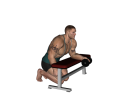 Wrist Curl - Kneeling Dumbbell Single
Wrist Curl - Kneeling Dumbbell Single
Benefits: This exercise focuses on the wrist flexors with the forearms supinated.
Purpose: This exercise strengthens the muscles that flex the wrist.
Beginner Forearms Strength Dumbbell Flat Bench Pull Gym
General Info: A complete forearm program must achieve balanced development for all major forearm muscles. The forearm is involved in six different forearm movements. They include wrist flexion, wrist extension, wrist abduction, wrist adduction, forearm pronation, and forearm supination. There are additional muscles found in the forearm that are involved in movements like elbow flexion (brachioradialis), finger flexion, and finger extension.
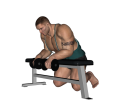 Wrist Curl - Palms Down Dumbbell Over Bench
Wrist Curl - Palms Down Dumbbell Over Bench
Benefits: This exercise focuses on the wrist extensors and indirectly on the brachioradialis.
Purpose: This exercise strengthens the muscles that extend the wrist.
Beginner Forearms Strength Dumbbell Flat Bench Pull Gym
General Info: A complete forearm program must achieve balanced development for all major forearm muscles. The forearm is involved in six different forearm movements. They include wrist flexion, wrist extension, wrist abduction, wrist adduction, forearm pronation, and forearm supination. There are additional muscles found in the forearm that are involved in movements like elbow flexion (brachioradialis), finger flexion, and finger extension.
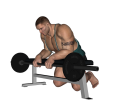 Wrist Curl - Palms Down Over Bench
Wrist Curl - Palms Down Over Bench
Benefits: This exercise focuses on the wrist extensors and indirectly on the brachioradialis.
Purpose: This exercise strengthens the muscles that extend the wrist.
Beginner Forearms Strength Barbell Flat Bench Pull Gym
General Info: A complete forearm program must achieve balanced development for all major forearm muscles. The forearm is involved in six different forearm movements. They include wrist flexion, wrist extension, wrist abduction, wrist adduction, forearm pronation, and forearm supination. There are additional muscles found in the forearm that are involved in movements like elbow flexion (brachioradialis), finger flexion, and finger extension.
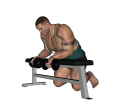 Wrist Curl - Palms Up Dumbbell Over Bench
Wrist Curl - Palms Up Dumbbell Over Bench
Benefits: This exercise focuses on the wrist flexors with the forearms supinated.
Purpose: This exercise strengthens the muscles that flex the wrist.
Beginner Forearms Strength Dumbbell Flat Bench Pull Gym
General Info: A complete forearm program must achieve balanced development for all major forearm muscles. The forearm is involved in six different forearm movements. They include wrist flexion, wrist extension, wrist abduction, wrist adduction, forearm pronation, and forearm supination. There are additional muscles found in the forearm that are involved in movements like elbow flexion (brachioradialis), finger flexion, and finger extension.
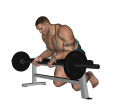 Wrist Curl - Palms Up Over Bench
Wrist Curl - Palms Up Over Bench
Benefits: This exercise focuses on the wrist flexors with the forearms supinated.
Purpose: This exercise strengthens the muscles that flex the wrist.
Beginner Forearms Strength Barbell Flat Bench Pull Gym
General Info: A complete forearm program must achieve balanced development for all major forearm muscles. The forearm is involved in six different forearm movements. They include wrist flexion, wrist extension, wrist abduction, wrist adduction, forearm pronation, and forearm supination. There are additional muscles found in the forearm that are involved in movements like elbow flexion (brachioradialis), finger flexion, and finger extension.
 Wrist Curl - Reverse Barbell
Wrist Curl - Reverse Barbell
Benefits: This exercise focuses on the wrist extensors and indirectly on the brachioradialis.
Purpose: This exercise strengthens the muscles that extend the wrist.
Beginner Forearms Strength Barbell Flat Bench Pull Gym
General Info: A complete forearm program must achieve balanced development for all major forearm muscles. The forearm is involved in six different forearm movements. They include wrist flexion, wrist extension, wrist abduction, wrist adduction, forearm pronation, and forearm supination. There are additional muscles found in the forearm that are involved in movements like elbow flexion (brachioradialis), finger flexion, and finger extension.
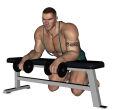 Wrist Curl - Reverse Dumbbell
Wrist Curl - Reverse Dumbbell
Benefits: This exercise focuses on the wrist extensors and indirectly on the brachioradialis.
Purpose: This exercise strengthens the muscles that extend the wrist.
Beginner Forearms Strength Dumbbell Flat Bench Pull Gym
General Info: A complete forearm program must achieve balanced development for all major forearm muscles. The forearm is involved in six different forearm movements. They include wrist flexion, wrist extension, wrist abduction, wrist adduction, forearm pronation, and forearm supination. There are additional muscles found in the forearm that are involved in movements like elbow flexion (brachioradialis), finger flexion, and finger extension.
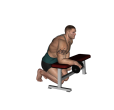 Wrist Curl - Reverse Dumbbell Single
Wrist Curl - Reverse Dumbbell Single
Benefits: This exercise focuses on the wrist extensors and indirectly on the brachioradialis.
Purpose: This exercise strengthens the muscles that extend the wrist.
Beginner Forearms Strength Dumbbell Flat Bench Pull Gym
General Info: A complete forearm program must achieve balanced development for all major forearm muscles. The forearm is involved in six different forearm movements. They include wrist flexion, wrist extension, wrist abduction, wrist adduction, forearm pronation, and forearm supination. There are additional muscles found in the forearm that are involved in movements like elbow flexion (brachioradialis), finger flexion, and finger extension.
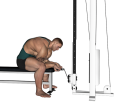 Wrist Curl - Seated 2 Arm Low Pulley
Wrist Curl - Seated 2 Arm Low Pulley
Benefits: This exercise focuses on the wrist flexors with the forearms supinated.
Purpose: This exercise strengthens the muscles that flex the wrist.
Beginner Forearms Strength High Low Cable Machine Flat Bench Pull Gym
General Info: A complete forearm program must achieve balanced development for all major forearm muscles. The forearm is involved in six different forearm movements. They include wrist flexion, wrist extension, wrist abduction, wrist adduction, forearm pronation, and forearm supination. There are additional muscles found in the forearm that are involved in movements like elbow flexion (brachioradialis), finger flexion, and finger extension.
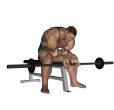 Wrist Curl - Seated Barbell
Wrist Curl - Seated Barbell
Benefits: This exercise focuses on the wrist flexors with the forearms supinated.
Purpose: This exercise strengthens the muscles that flex the wrist.
Beginner Forearms Strength Barbell Flat Bench Pull Gym
General Info: A complete forearm program must achieve balanced development for all major forearm muscles. The forearm is involved in six different forearm movements. They include wrist flexion, wrist extension, wrist abduction, wrist adduction, forearm pronation, and forearm supination. There are additional muscles found in the forearm that are involved in movements like elbow flexion (brachioradialis), finger flexion, and finger extension.
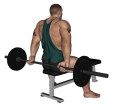 Wrist Curl - Seated Barbell Behind
Wrist Curl - Seated Barbell Behind
Benefits: This exercise isolates the wrist flexors with little involvement of the brachioradialis.
Purpose: This exercise strengthens the muscles that flex the wrist.
Beginner Forearms Strength Barbell Flat Bench Pull Gym
General Info: A complete forearm program must achieve balanced development for all major forearm muscles. The forearm is involved in six different forearm movements. They include wrist flexion, wrist extension, wrist abduction, wrist adduction, forearm pronation, and forearm supination. There are additional muscles found in the forearm that are involved in movements like elbow flexion (brachioradialis), finger flexion, and finger extension.
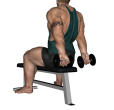 Wrist Curl - Seated Behind Dumbbell
Wrist Curl - Seated Behind Dumbbell
Benefits: This exercise focuses on the wrist flexors with the forearms supinated.
Purpose: This exercise strengthens the muscles that flex the wrist.
Beginner Forearms Strength Barbell Flat Bench Pull Gym
General Info: A complete forearm program must achieve balanced development for all major forearm muscles. The forearm is involved in six different forearm movements. They include wrist flexion, wrist extension, wrist abduction, wrist adduction, forearm pronation, and forearm supination. There are additional muscles found in the forearm that are involved in movements like elbow flexion (brachioradialis), finger flexion, and finger extension.
 Wrist Curl - Seated Chains
Wrist Curl - Seated Chains
Benefits: This exercise is done with the addition of chains. The primary function of chains is to accommodate resistance. Chains are also a great means of weight loading (adding more weight to an exercise). Chains are also a great way for working the stabilizers.
Purpose: Benefits This exercise focuses on the wrist flexors with the forearms supinated.
Beginner Forearms Strength Chains Flat Bench Pull Gym
General Info: A complete forearm program must achieve balanced development for all major forearm muscles. The forearm is involved in six different forearm movements. They include wrist flexion, wrist extension, wrist abduction, wrist adduction, forearm pronation, and forearm supination. There are additional muscles found in the forearm that are involved in movements like elbow flexion (brachioradialis), finger flexion, and finger extension.
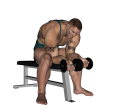 Wrist Curl - Seated Dumbbell
Wrist Curl - Seated Dumbbell
Benefits: This exercise focuses on the wrist flexors with the forearms supinated.
Purpose: This exercise strengthens the muscles that flex the wrist.
Beginner Forearms Strength Dumbbell Flat Bench Pull Gym
General Info: A complete forearm program must achieve balanced development for all major forearm muscles. The forearm is involved in six different forearm movements. They include wrist flexion, wrist extension, wrist abduction, wrist adduction, forearm pronation, and forearm supination. There are additional muscles found in the forearm that are involved in movements like elbow flexion (brachioradialis), finger flexion, and finger extension.
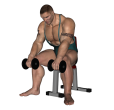 Wrist Curl - Seated Dumbbell Palms Down
Wrist Curl - Seated Dumbbell Palms Down
Benefits: This exercise focuses on the wrist extensors with the forearms pronated.
Purpose: This exercise strengthens the muscles that flex the wrist.
Beginner Forearms Strength Dumbbell Flat Bench Pull Gym
General Info: A complete forearm program must achieve balanced development for all major forearm muscles. The forearm is involved in six different forearm movements. They include wrist flexion, wrist extension, wrist abduction, wrist adduction, forearm pronation, and forearm supination. There are additional muscles found in the forearm that are involved in movements like elbow flexion (brachioradialis), finger flexion, and finger extension.
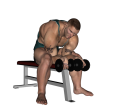 Wrist Curl - Seated Dumbbell Palms Up
Wrist Curl - Seated Dumbbell Palms Up
Benefits: This exercise focuses on the wrist flexors with the forearms supinated.
Purpose: This exercise strengthens the muscles that flex the wrist.
Beginner Forearms Strength Dumbbell Flat Bench Pull Gym
General Info: A complete forearm program must achieve balanced development for all major forearm muscles. The forearm is involved in six different forearm movements. They include wrist flexion, wrist extension, wrist abduction, wrist adduction, forearm pronation, and forearm supination. There are additional muscles found in the forearm that are involved in movements like elbow flexion (brachioradialis), finger flexion, and finger extension.
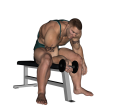 Wrist Curl - Seated Dumbbell Single
Wrist Curl - Seated Dumbbell Single
Benefits: This exercise focuses on the wrist flexors with the forearms supinated.
Purpose: This exercise strengthens the muscles that flex the wrist.
Beginner Forearms Strength Dumbbell Flat Bench Pull Gym
General Info: A complete forearm program must achieve balanced development for all major forearm muscles. The forearm is involved in six different forearm movements. They include wrist flexion, wrist extension, wrist abduction, wrist adduction, forearm pronation, and forearm supination. There are additional muscles found in the forearm that are involved in movements like elbow flexion (brachioradialis), finger flexion, and finger extension.
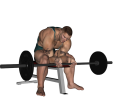 Wrist Curl - Seated Palms Up Barbell
Wrist Curl - Seated Palms Up Barbell
Benefits: This exercise focuses on the wrist flexors with the forearms supinated.
Purpose: This exercise strengthens the muscles that flex the wrist.
Beginner Forearms Strength Barbell Flat Bench Pull Gym
General Info: A complete forearm program must achieve balanced development for all major forearm muscles. The forearm is involved in six different forearm movements. They include wrist flexion, wrist extension, wrist abduction, wrist adduction, forearm pronation, and forearm supination. There are additional muscles found in the forearm that are involved in movements like elbow flexion (brachioradialis), finger flexion, and finger extension.
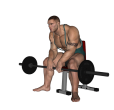 Wrist Curl - Seated Reverse Barbell
Wrist Curl - Seated Reverse Barbell
Benefits: This exercise focuses on the wrist extensors with the forearms pronated.
Purpose: This exercise strengthens the muscles that flex the wrist.
Beginner Forearms Strength Barbell Flat Bench Pull Gym
General Info: A complete forearm program must achieve balanced development for all major forearm muscles. The forearm is involved in six different forearm movements. They include wrist flexion, wrist extension, wrist abduction, wrist adduction, forearm pronation, and forearm supination. There are additional muscles found in the forearm that are involved in movements like elbow flexion (brachioradialis), finger flexion, and finger extension.
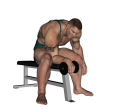 Wrist Curl - Seated Reverse Dumbbell Single
Wrist Curl - Seated Reverse Dumbbell Single
Benefits: This exercise focuses on the wrist flexors with the forearms supinated.
Purpose: This exercise strengthens the muscles that flex the wrist.
Beginner Forearms Strength Dumbbell Flat Bench Pull Gym
General Info: A complete forearm program must achieve balanced development for all major forearm muscles. The forearm is involved in six different forearm movements. They include wrist flexion, wrist extension, wrist abduction, wrist adduction, forearm pronation, and forearm supination. There are additional muscles found in the forearm that are involved in movements like elbow flexion (brachioradialis), finger flexion, and finger extension.
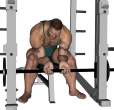 Wrist Curl - Smith Machine
Wrist Curl - Smith Machine
Benefits: This exercise focuses on the wrist flexors with the forearms supinated.
Purpose: This exercise strengthens the muscles that flex the wrist.
Beginner Forearms Strength Smith Machine Flat Bench Pull Gym
General Info: A complete forearm program must achieve balanced development for all major forearm muscles. The forearm is involved in six different forearm movements. They include wrist flexion, wrist extension, wrist abduction, wrist adduction, forearm pronation, and forearm supination. There are additional muscles found in the forearm that are involved in movements like elbow flexion (brachioradialis), finger flexion, and finger extension.
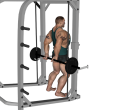 Wrist Curl - Smith Machine Behind
Wrist Curl - Smith Machine Behind
Benefits: This exercise isolates the wrist flexors with little involvement of the brachioradialis.
Purpose: This exercise strengthens the muscles that flex the wrist.
Beginner Forearms Strength Smith Machine Pull Gym
General Info: A complete forearm program must achieve balanced development for all major forearm muscles. The forearm is involved in six different forearm movements. They include wrist flexion, wrist extension, wrist abduction, wrist adduction, forearm pronation, and forearm supination. There are additional muscles found in the forearm that are involved in movements like elbow flexion (brachioradialis), finger flexion, and finger extension.
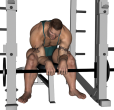 Wrist Curl - Smith Machine Reverse
Wrist Curl - Smith Machine Reverse
Benefits: This exercise focuses on the wrist flexors with the forearms supinated.
Purpose: This exercise strengthens the muscles that flex the wrist.
Beginner Forearms Strength Smith Machine Flat Bench Pull Gym
General Info: A complete forearm program must achieve balanced development for all major forearm muscles. The forearm is involved in six different forearm movements. They include wrist flexion, wrist extension, wrist abduction, wrist adduction, forearm pronation, and forearm supination. There are additional muscles found in the forearm that are involved in movements like elbow flexion (brachioradialis), finger flexion, and finger extension.
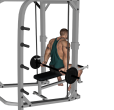 Wrist Curl - Smith Machine Seated Behind Back
Wrist Curl - Smith Machine Seated Behind Back
Benefits: This exercise isolates the wrist flexors with little involvement of the brachioradialis.
Purpose: This exercise strengthens the muscles that flex the wrist.
Beginner Forearms Strength Smith Machine Flat Bench Pull Gym
General Info: A complete forearm program must achieve balanced development for all major forearm muscles. The forearm is involved in six different forearm movements. They include wrist flexion, wrist extension, wrist abduction, wrist adduction, forearm pronation, and forearm supination. There are additional muscles found in the forearm that are involved in movements like elbow flexion (brachioradialis), finger flexion, and finger extension.
 Wrist Curl - Smith Machine Standing
Wrist Curl - Smith Machine Standing
Benefits: This exercise focuses on the wrist flexors with the forearms supinated.
Purpose: This exercise strengthens the muscles that flex the wrist.
Beginner Forearms Strength Smith Machine Pull Gym
General Info: A complete forearm program must achieve balanced development for all major forearm muscles. The forearm is involved in six different forearm movements. They include wrist flexion, wrist extension, wrist abduction, wrist adduction, forearm pronation, and forearm supination. There are additional muscles found in the forearm that are involved in movements like elbow flexion (brachioradialis), finger flexion, and finger extension.
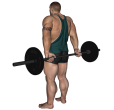 Wrist Curl - Standing Bar Behind Back
Wrist Curl - Standing Bar Behind Back
Benefits: This exercise isolates the wrist flexors with little involvement of the brachioradialis.
Purpose: This exercise strengthens the muscles that flex the wrist.
Beginner Forearms Strength Barbell Pull Gym
General Info: A complete forearm program must achieve balanced development for all major forearm muscles. The forearm is involved in six different forearm movements. They include wrist flexion, wrist extension, wrist abduction, wrist adduction, forearm pronation, and forearm supination. There are additional muscles found in the forearm that are involved in movements like elbow flexion (brachioradialis), finger flexion, and finger extension.
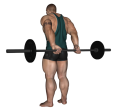 Wrist Curl - Standing Bar Behind Close Grip
Wrist Curl - Standing Bar Behind Close Grip
Benefits: This exercise isolates the wrist flexors with little involvement of the brachioradialis.
Purpose: This exercise strengthens the muscles that flex the wrist.
Beginner Forearms Strength Barbell Pull Gym
General Info: A complete forearm program must achieve balanced development for all major forearm muscles. The forearm is involved in six different forearm movements. They include wrist flexion, wrist extension, wrist abduction, wrist adduction, forearm pronation, and forearm supination. There are additional muscles found in the forearm that are involved in movements like elbow flexion (brachioradialis), finger flexion, and finger extension.
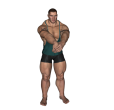 Wrist Pull - Side
Wrist Pull - Side
Benefits: This exercise helps to relax the shoulder.
Purpose: This exercise focuses on working the front shoulder joint and makes an excellent warm-up before any resistance or weigh training involving the shoulders.
Beginner Shoulders Lats Stretching Body Only Gym Home
General Info: The side wrist pull require little time, yet can give good benefits when done regularly. It can be done almost anywhere, without special equipment. The three heads of the deltoid muscles require regular movement to ensure their flexibility and mobility.
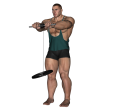 Wrist Roller - Basic
Wrist Roller - Basic
Benefits: This exercise focuses on both the wrist flexors and extensors with the forearms pronated.
Purpose: This exercise strengthens the muscles that flex and extend the wrist.
Beginner Forearms Strength Wrist Roller Pull Gym
General Info: A complete forearm program must achieve balanced development for all major forearm muscles. The forearm is involved in six different forearm movements. They include wrist flexion, wrist extension, wrist abduction, wrist adduction, forearm pronation, and forearm supination. There are additional muscles found in the forearm that are involved in movements like elbow flexion (brachioradialis), finger flexion, and finger extension.
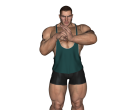 Wrist Stretch - Back Variation 1
Wrist Stretch - Back Variation 1
Benefits: This exercise focuses on the back of the wrist, a muscle group that hardly is ever exercised in the gym.
Purpose: This exercise stretches the tendons running down the back of the wrist.
Beginner Forearms Strength Body Only Pull Gym
General Info: A complete forearm program must achieve balanced development for all major forearm muscles. The forearm is involved in six different forearm movements. They include wrist flexion, wrist extension, wrist abduction, wrist adduction, forearm pronation, and forearm supination. There are additional muscles found in the forearm that are involved in movements like elbow flexion (brachioradialis), finger flexion, and finger extension.
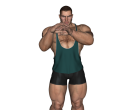 Wrist Stretch - Back Variation 2
Wrist Stretch - Back Variation 2
Benefits: This exercise focuses on the back of the wrist, a muscle group that hardly is ever exercised in the gym.
Purpose: This exercise stretches the thumb tendons and the tendons running down the back of the wrist.
Beginner Forearms Strength Body Only Pull Gym
General Info: A complete forearm program must achieve balanced development for all major forearm muscles. The forearm is involved in six different forearm movements. They include wrist flexion, wrist extension, wrist abduction, wrist adduction, forearm pronation, and forearm supination. There are additional muscles found in the forearm that are involved in movements like elbow flexion (brachioradialis), finger flexion, and finger extension.
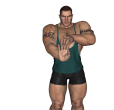 Wrist Stretch - Front
Wrist Stretch - Front
Benefits: This exercise focuses on the front of the wrist, a muscle group that hardly is ever exercised in the gym.
Purpose: This exercise stretches the tendons running down the front of the wrist.
Beginner Forearms Strength Body Only Pull Gym
General Info: A complete forearm program must achieve balanced development for all major forearm muscles. The forearm is involved in six different forearm movements. They include wrist flexion, wrist extension, wrist abduction, wrist adduction, forearm pronation, and forearm supination. There are additional muscles found in the forearm that are involved in movements like elbow flexion (brachioradialis), finger flexion, and finger extension.
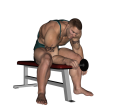 Wrist Twist - Single Ended Dumbbell
Wrist Twist - Single Ended Dumbbell
Benefits: This exercise focuses on the wrist adductors, a muscle group that hardly is ever exercised in the gym.
Purpose: This exercise strengthens the muscles that adduct the wrist.
Beginner Forearms Strength Single Ended Dumbbell Flat Bench Pull Gym
General Info: A complete forearm program must achieve balanced development for all major forearm muscles. The forearm is involved in six different forearm movements. They include wrist flexion, wrist extension, wrist abduction, wrist adduction, forearm pronation, and forearm supination. There are additional muscles found in the forearm that are involved in movements like elbow flexion (brachioradialis), finger flexion, and finger extension.
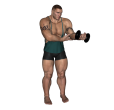 Wrist Twist - Standing Dumbbell One Wrist
Wrist Twist - Standing Dumbbell One Wrist
Benefits: This exercise focuses on the wrist adductors, a muscle group that hardly is ever exercised in the gym.
Purpose: This exercise strengthens the muscles that adduct the wrist.
Beginner Forearms Strength Single Ended Dumbbell Pull Gym
General Info: A complete forearm program must achieve balanced development for all major forearm muscles. The forearm is involved in six different forearm movements. They include wrist flexion, wrist extension, wrist abduction, wrist adduction, forearm pronation, and forearm supination. There are additional muscles found in the forearm that are involved in movements like elbow flexion (brachioradialis), finger flexion, and finger extension.
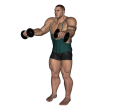 Wrist Twist - Standing Dumbbell Two Wrist
Wrist Twist - Standing Dumbbell Two Wrist
Benefits: This exercise focuses on the wrist adductors, a muscle group that hardly is ever exercised in the gym.
Purpose: This exercise strengthens the muscles that adduct the wrist.
Beginner Forearms Strength Single Ended Dumbbell Pull Gym
General Info: A complete forearm program must achieve balanced development for all major forearm muscles. The forearm is involved in six different forearm movements. They include wrist flexion, wrist extension, wrist abduction, wrist adduction, forearm pronation, and forearm supination. There are additional muscles found in the forearm that are involved in movements like elbow flexion (brachioradialis), finger flexion, and finger extension.
 Wrist Twist - Standing Water Bottle One Wrist
Wrist Twist - Standing Water Bottle One Wrist
Benefits: This exercise focuses on the wrist adductors, a muscle group that hardly is ever exercised in the gym.
Purpose: This exercise strengthens the muscles that adduct the wrist.
Beginner Forearms Strength Water Bottle Pull Home
General Info: A complete forearm program must achieve balanced development for all major forearm muscles. The forearm is involved in six different forearm movements. They include wrist flexion, wrist extension, wrist abduction, wrist adduction, forearm pronation, and forearm supination. There are additional muscles found in the forearm that are involved in movements like elbow flexion (brachioradialis), finger flexion, and finger extension.
 Wrist Twist - Standing Water Bottle Two Wrist
Wrist Twist - Standing Water Bottle Two Wrist
Benefits: This exercise focuses on the wrist adductors, a muscle group that hardly is ever exercised in the gym.
Purpose: This exercise strengthens the muscles that adduct the wrist.
Beginner Forearms Strength Water Bottle Pull Home
General Info: A complete forearm program must achieve balanced development for all major forearm muscles. The forearm is involved in six different forearm movements. They include wrist flexion, wrist extension, wrist abduction, wrist adduction, forearm pronation, and forearm supination. There are additional muscles found in the forearm that are involved in movements like elbow flexion (brachioradialis), finger flexion, and finger extension.
 Wrist Twist - Water Bottle
Wrist Twist - Water Bottle
Benefits: This exercise focuses on the wrist adductors, a muscle group that hardly is ever exercised in the gym.
Purpose: This exercise strengthens the muscles that adduct the wrist.
Beginner Forearms Strength Water Bottle Chair Pull Home
General Info: A complete forearm program must achieve balanced development for all major forearm muscles. The forearm is involved in six different forearm movements. They include wrist flexion, wrist extension, wrist abduction, wrist adduction, forearm pronation, and forearm supination. There are additional muscles found in the forearm that are involved in movements like elbow flexion (brachioradialis), finger flexion, and finger extension.
Could not find your favorite exercise in the list? Please start a discussion and post the name and the list of steps. We will try to add it as soon as we can.